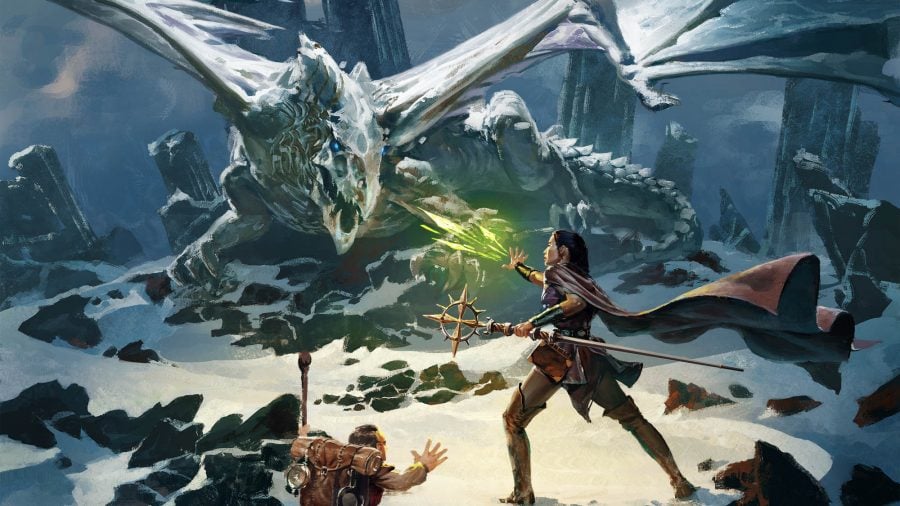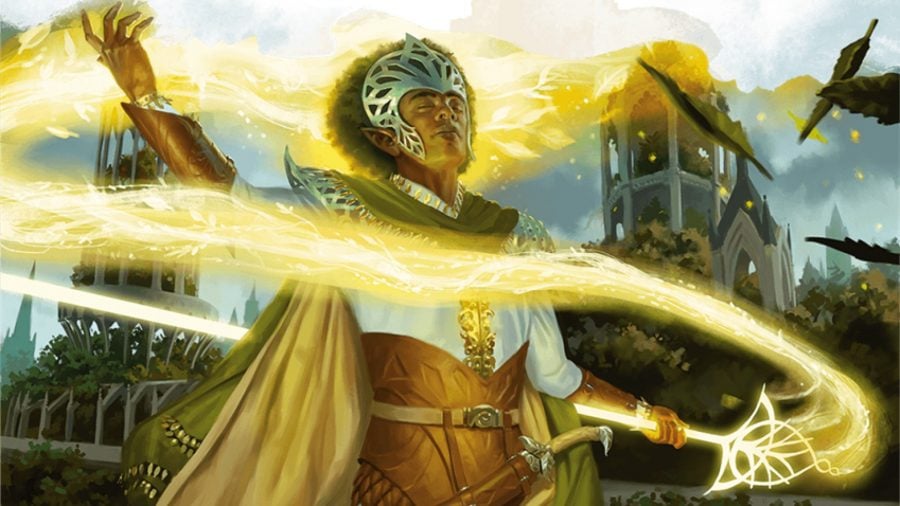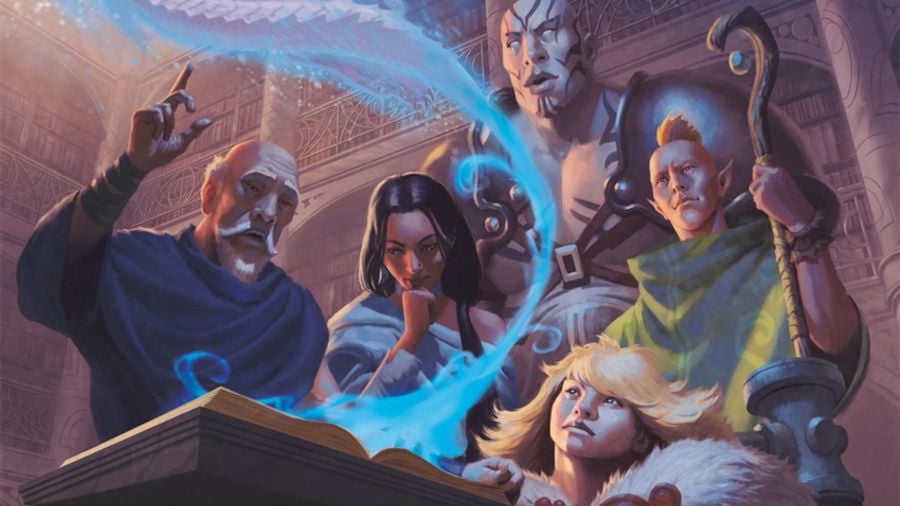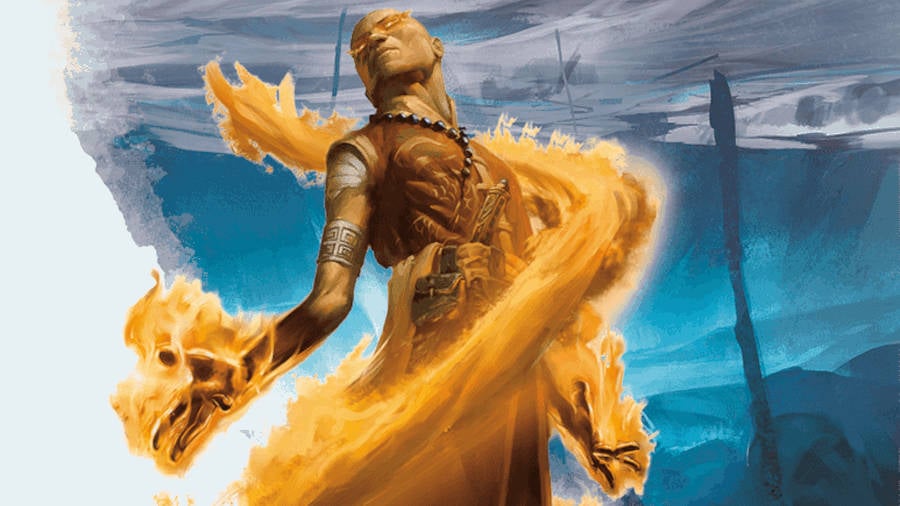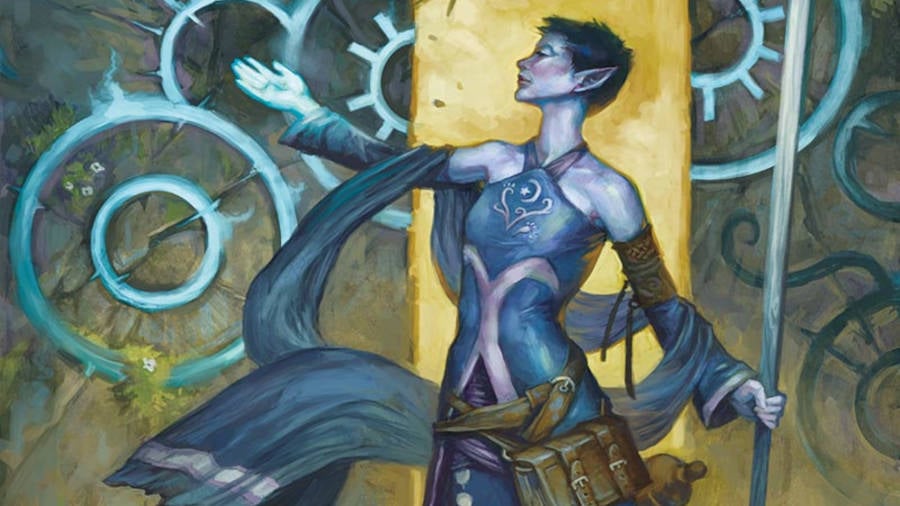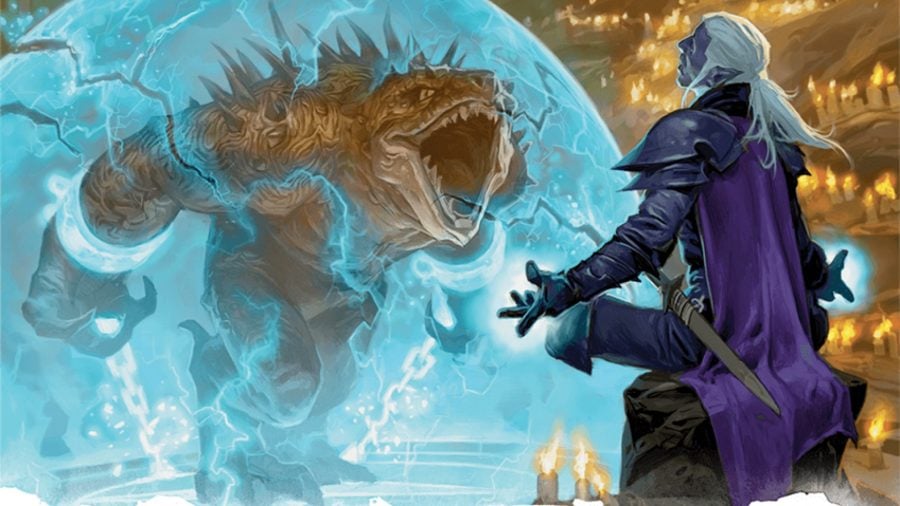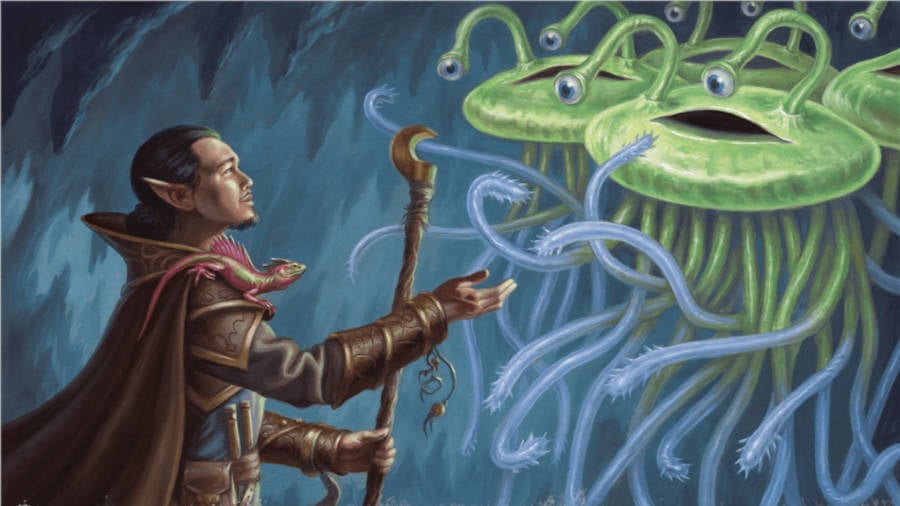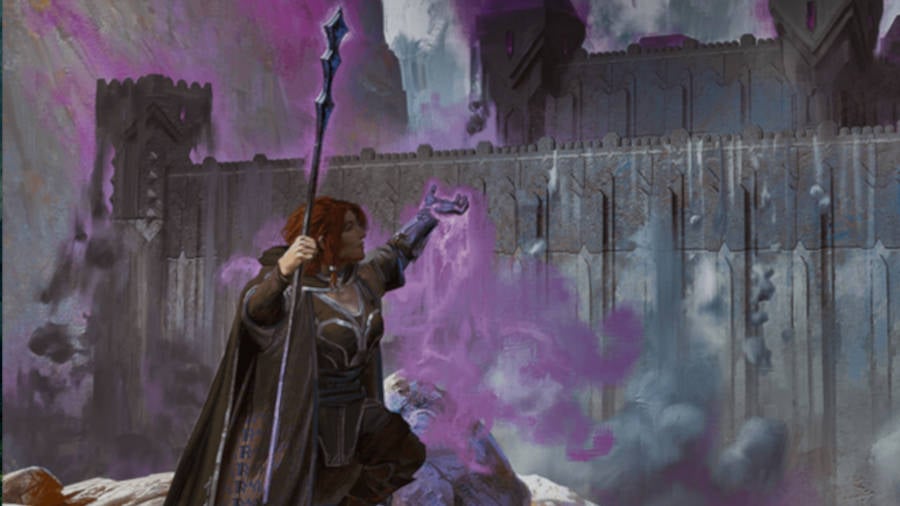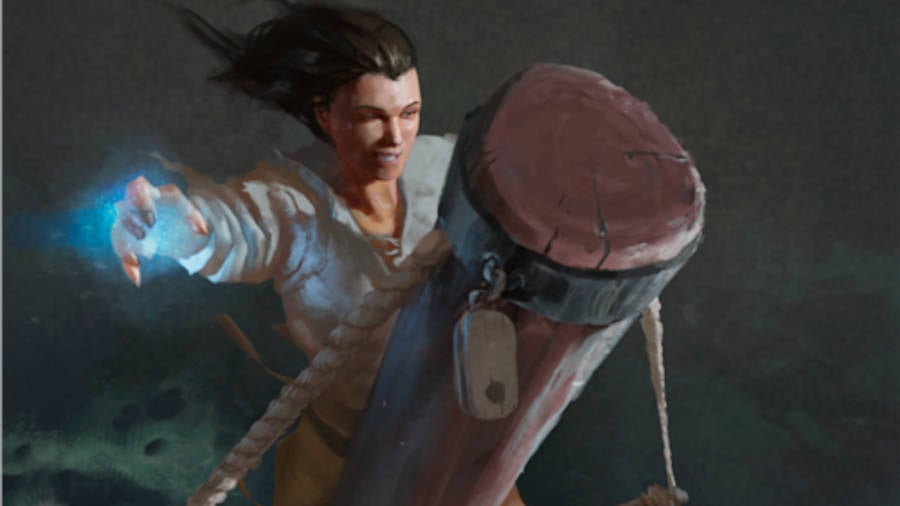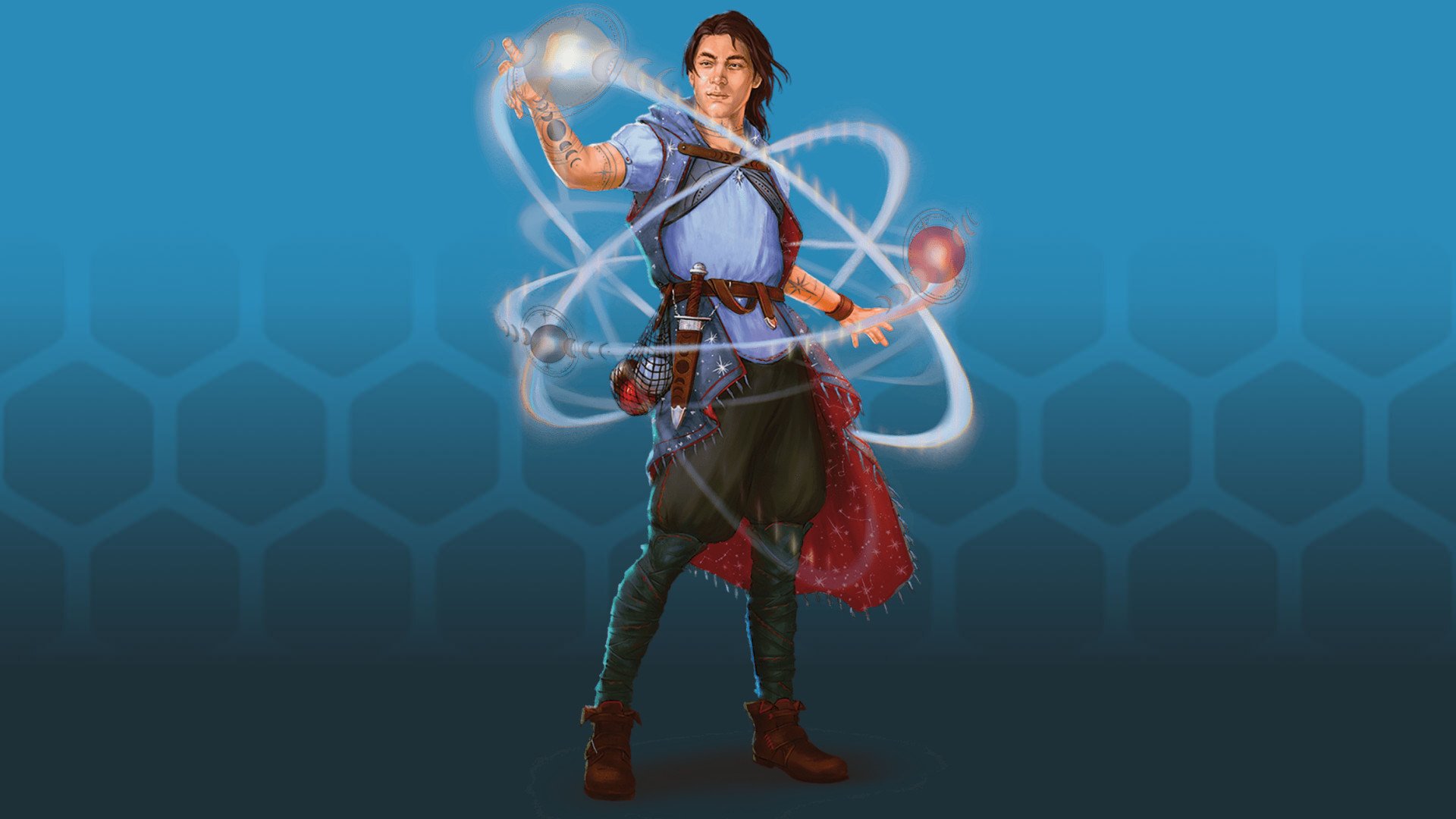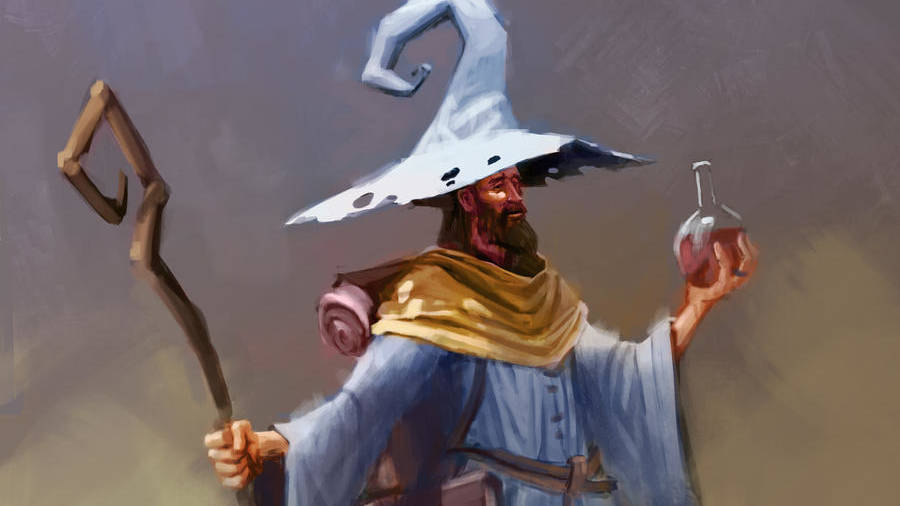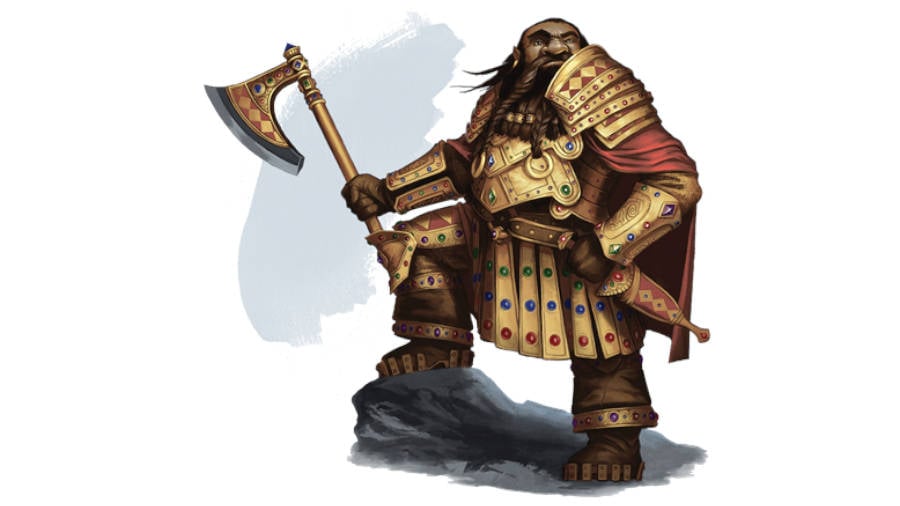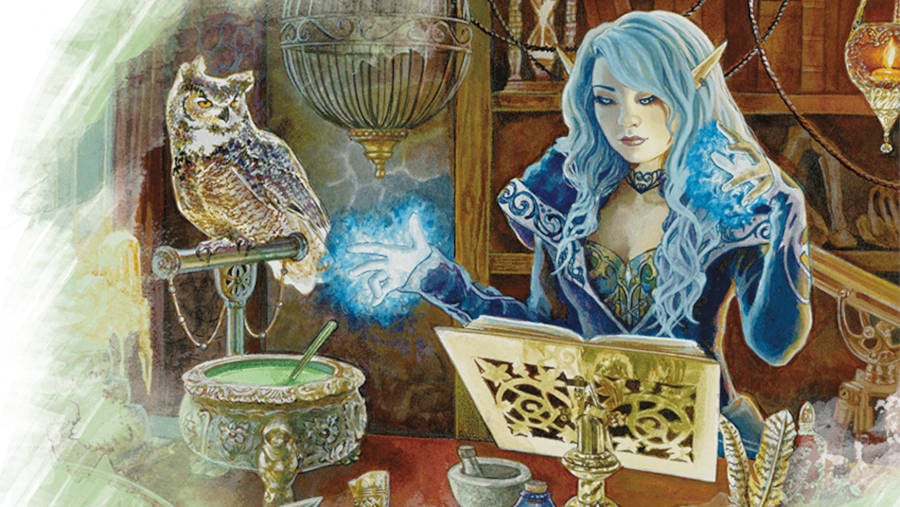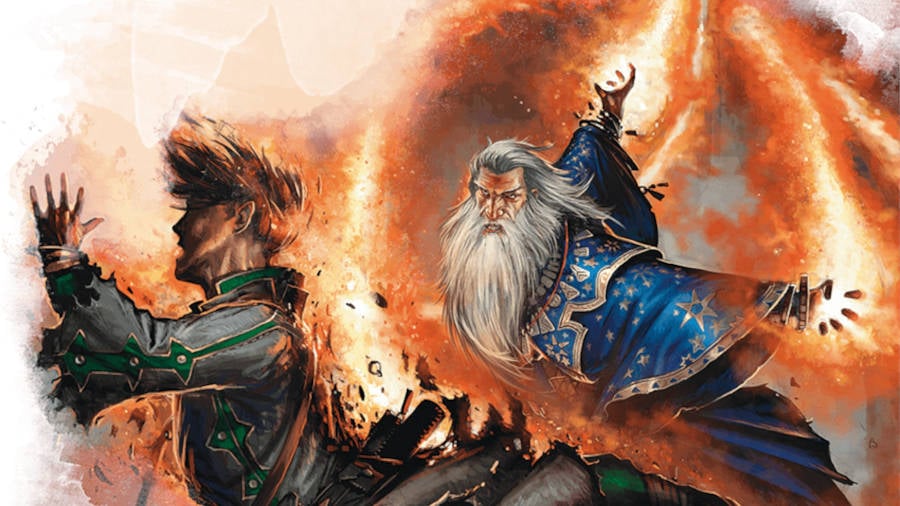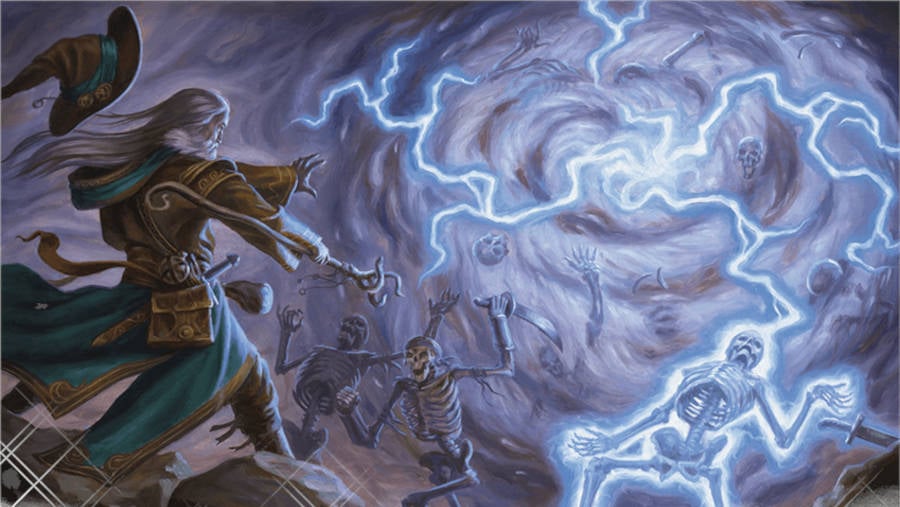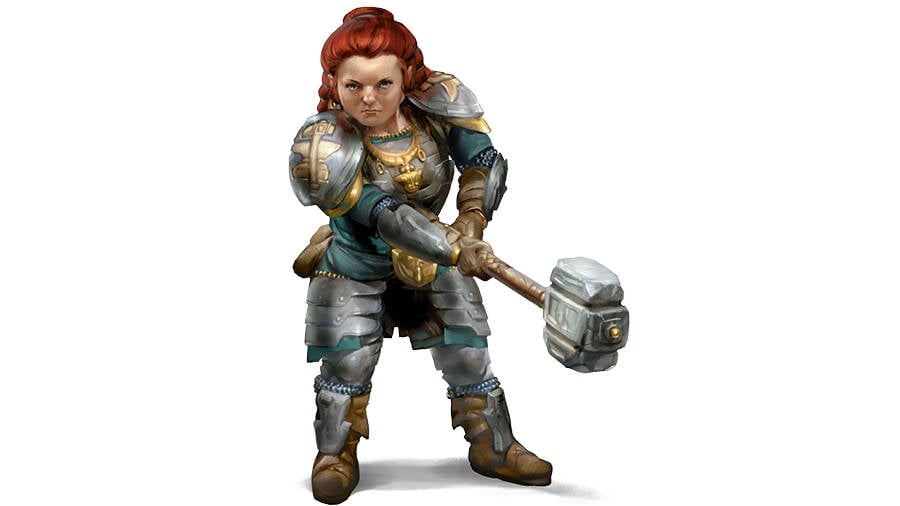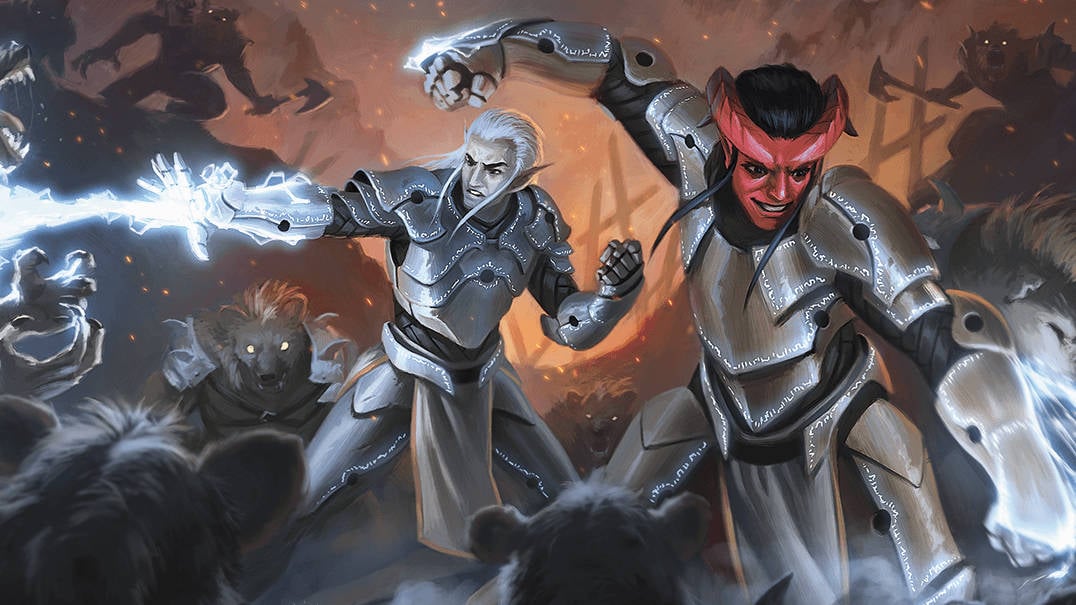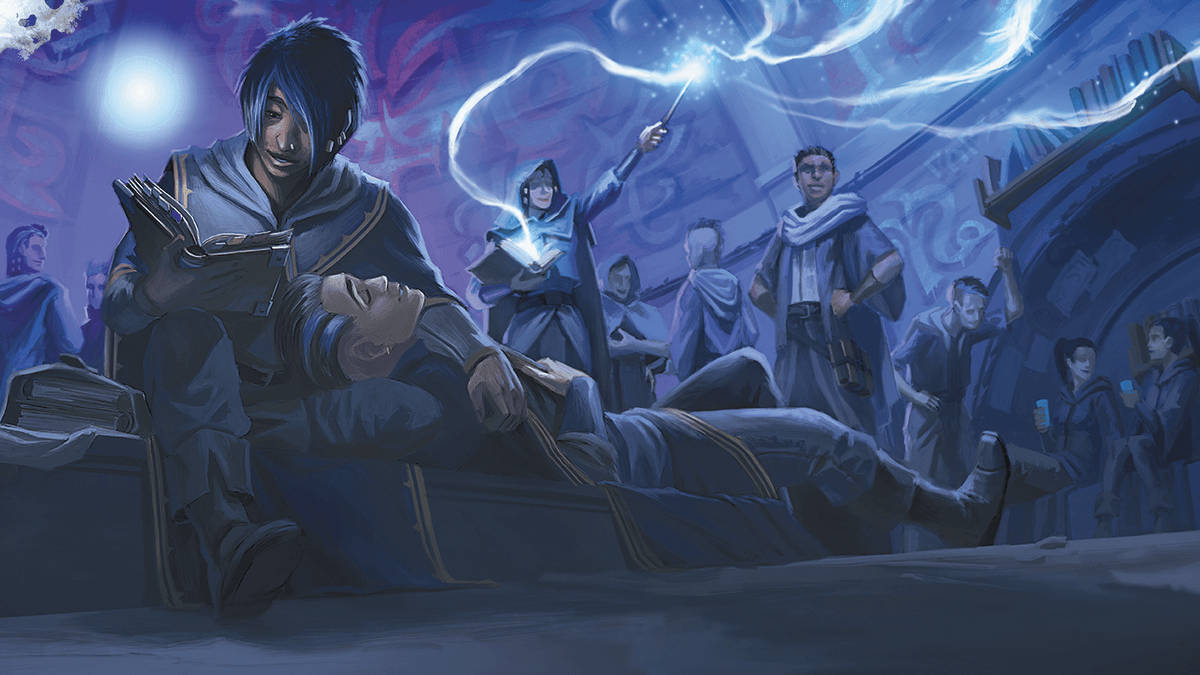Magic is something that a Wizard learns, and a Warlock bargains for. But, for Dungeons and Dragons’ Sorcerer 5e class, magic is something that you are. A powerful force lies within you, and, whether you’re excited by dominating the battlefield with exotic powers, or roleplaying a character touched by inhuman impulses, Sorcerer is not a class to be overlooked in Dungeons and Dragons.
The DnD Sorcerer class is, however, a finicky choice that can be hard to understand, and even harder to optimise. Pairing together their many disparate features is often a tricky prospect for new players, and even veteran adventurers might need a helping hand when navigating their innate magical capabilities. The Sorcerer 5e can make for a highly adept, damage-dealing wunderkind, but crafting a refined build that maximises their many interlocking abilities is a challenge.
So, to ease you in, here’s our comprehensive Sorcerer class guide. We’ll walk you through their many class features, delve into their powerful Metamagic, provide a rundown of the available subclasses, pick out some choice spells, and serve up some ready-made builds that you might want to take to the tabletop.
If you’re after an overview of all the classes on offer, check out our DnD classes guide, which walks you through the basic appeal and DnD stats of the core options. You should also check out our guides to DnD races, DnD character sheets, and free online DnD character creator tools to make character creation easy as pie.
But if powerful magic courses through your veins, beyond the wildest dreams of mere Wizard 5e or feeble Warlock 5e players, read on for our full DnD 5e Sorcerer guide.
Here’s how to play a DnD Sorcerer 5e:
Sorcerer stats 5e
These are the core Sorcerer stats 5e gives your character:
| Hit Dice | 1d6 per level |
| HP at Lvl Up | 1d6 (or 4) + Constitution modifier |
| Primary ability scores | Charisma |
| Armour proficiency | None |
| Weapon proficiency | Daggers, darts, slings, quarterstaffs, light crossbows |
| Tool proficiency | None |
| Skill proficiency | Two of: Arcana, Deception, Insight, Intimidation, Persuasion, Religion |
| Saving throws | Charisma and Constitution |
With a small pool of hit dice and no DnD armor proficiency, Sorcerers are often the more vulnerable members of any party. At first glance, the DnD weapons proficiencies aren’t much to look at, either, but don’t estimate that light crossbow option at low levels. If you have high Dex, it’ll hit harder than your DnD cantrips, until they get their first upgrade at fifth level.
Your saving throws are much kinder. Sorcerers are the only full caster to apply their proficiency to Constitution saves. This makes Sorcerers more reliable than any other class with powerful concentration 5e spells, such as DnD Haste and Dominate Person. After all, the save to keep your spell running when an Orc’s axe comes to an abrupt stop in your beautiful face is a Con save.
For most Sorcerers, Charisma is going to be their most important ability score. It determines the effectiveness of their spells and may influence some bloodline powers. Sorcerers can also use Persuasion and Deception as Cha skills, which opens up a variety of less explosive options in dealing with important encounters. Not every Sorcerer needs both; you could have an interesting game playing a character that’s fundamentally honest or dishonest.
Other abilities of note include Strength, Dexterity, and Constitution. Some Sorcerers use magic to enhance their weapon attacks, which are based on Str or Dex. The latter is also valuable for improving armour class, as it enhances the effects of mage armour or draconic skin. Finally, in addition to boosting concentration saves, Con will also grant the extra hit points that a Sorcerer’s poor d6 hit dice is unwilling to provide.
Sorcerer class features 5e
| Feature | Level |
| Spellcasting | 1 – 20 |
| Sorcerous Origin | 1, 6, 14, 18 |
| Font of Magic | 2 – 20 |
| Metamagic | 3, 10, 17 |
| Ability Score Improvement | 4, 8, 12, 16, 20 |
| Sorcerous Restoration | 20 |
Spellcasting makes up the bread and butter of the Sorcerer. As a Sorcerer you have the highest number of daily spell slots available to a character of their level (tied with the Bard 5e, Cleric 5e, Druid 5e, and Wizard). However, you can only choose a relatively limited number of spells to cast, and, unlike most of those other classes, may only change your decision when you level up. Choose wisely!
The effects of the Sorcerous Origin feature are determined entirely by the Sorcerer’s archetype. Most offer some sort of enhancement that improves your spellcasting, such as improving the damage of your cantrips or adding extra effects to the spells you cast. We’ll discuss each in detail later.
Font of Magic allows you to turn spell slots into Sorcery Points, and then turn Sorcery Points back into spell slots of a higher level. This may sound like a bad deal, and when you first gain the power it is. But, like a fine wine, it improves with time. Once you’ve got third or fourth-level slots it starts becoming worth using this ability; converting one type of slot into another.
Exploring a long dungeon with few opportunities for rest, and worried about running out of spells? Break your high-level spells into several lower-level spells, and continue to cast every round. Preparing for a single climactic battle with the dark overlord of the horde? Convert all of your slots into the highest level you can cast, and make every turn the best it can be.
Metamagic offers another way to spend Sorcery Points: modifying spells as you cast them. This allows you to create effects that would usually be impossible and grants the opportunity to expend more of your power in a single turn. You start out with two Metamagic effects and will gain another two as you level. You can’t change them, so pick options you’ll be comfortable using for a long time.
A cheeky peek at 5e feats that give +1 Cha can be worth it if you started with an odd score. Tasha’s Cauldron of Everything is your friend here. Shadow Touched and Fey Touched both increase your spell variety, while Telekinetic will give you something fun to do with your underutilised bonus action each round.
Finally, Sorcerous Restoration awaits those who reach the giddy heights of level twenty. This allows you, for the first time, to get something useful out of short rests. Reliably replenishing Sorcery Points now means that you can use metamagic every fight, and can stop trying to talk the party into making every rest an eight-hour rest.
Metamagic
Casting spells as written is for suckers. A Sorcerer rewrites the spells to suit them, and Metamagic is how they do it. Using Metamagic is simple: cross off the Sorcery Points as you cast the spell, and modify it as appropriate. It doesn’t cost an extra action, but remember that you can only modify each spell once. No quickened, heightened, and maximised sonic fireballs in fifth edition.
Since you only choose a few Metamagic tricks and are stuck with them forever, it’s worth taking a moment to consider your options:
Player’s Handbook options
Careful Spell
Create holes in your AoE spells to leave allies unharmed (or less harmed, at least). Useful if your DM is fond of placing large groups of enemies in tightly packed environments.
Distant Spell
Increase the range of a spell. In most situations, spell ranges are so long that doubling them is no big deal, but the neat thing about this option is the ability to extend a touch spell to a 30-foot range. Ranged touch attacks are passable, but having a Divine Soul Sorcerer chucking ranged Cure Wounds into situations they’d rather not enter is where this Metamagic option really shines.
Empowered Spell
Reroll some of the damage dice you just rolled. This option becomes more useful the more dice you’re rolling, and it’s an exception to the ‘one Metamagic trick per spell’ rule. This is the mule of Metamagic options: it’s reliably useful but doesn’t do anything flashy.
Extended Spell
Doubles the duration of a spell that lasts at least a minute. This one is pretty situational, since many fights are over in under a minute, and most journeys are long enough that doubling a spell’s duration isn’t enough to keep it active across multiple encounters.
Heightened Spell
Gives a target disadvantage on its saving throw. At low levels the effect often isn’t worth three Sorcery Points, but at high levels you’ll have more points to spare, and be throwing around effects save-or-die spells, so it really starts to shine.
Quickened Spell
Reduces the casting time of a spell to a bonus action. Doing two things in a turn is fantastic, and many Sorcerers will want this, but don’t forget the easily overlooked rule that casting a spell as a bonus action prevents you from casting any spell with a spell slot as your main action. It pairs best with a great cantrip.
Subtle Spell
Cast a spell without saying any words or moving your hands. Equally valuable for starting fights without taking the blame, and escaping (un)just imprisonment. To get the most fun out of this, boost your Cha, and bump that Deception skill.
Twinned Spell
Cast a single target spell and hit two targets. A powerhouse at low levels, since the cost depends on the level of the original spell, but comparatively expensive for enhancing higher level options. One of the hidden benefits of this option is the ability to do twice as much with concentration, such as by using a twinned Hold Person 5e to keep two people held at once.
Tasha’s Cauldron of Everything options
Seeking Spell
When you miss with a spell that uses an attack roll, spend some Sorcery Points to reroll. This option is a little more efficient than the comparable Heighten spell because you only spend the points after you, rather than when you think your enemy might save.
Transmuted Spell
Converts a spell from one energy type to another. Often this won’t do much, but it lets you exploit enemies with particular weaknesses. It can also be used for thematic reasons; if you’re trying to build some sort of ice princess on a journey of personal discovery, say, and want all of your spells to be cold-themed.
Sorcerer subclasses 5e
A Sorcerer’s power comes from their bloodline being touched by a powerful entity or force. These Sorcerous Origins form the Sorcerer subclasses 5e offers; your character’s choice defines what sort of force fires them, and gives the Sorcerer a suite of abilities to call on above and beyond their usual spellcasting.
Draconic Bloodline
| Level | Subclass abilities |
| 1 | Dragon Ancestor, Draconic Resilience |
| 6 | Elemental Affinity |
| 14 | Dragon Wings |
| 18 | Draconic Presence |
Most of the powers this archetype offers are intended to help you feel closer to being a dragon. Having armoured skin, being able to fly, and sending enemies fleeing in fear are all great flavour, and provide excellent roleplaying opportunities to viscerally describe the physical changes that reflect these statistical bonuses.
However, as with Divine Soul, many of them mimic spells you could already cast. The Fly spell was available a whopping nine levels before you grew wings. The stand-out power here is Elemental Affinity, which is a powerhouse, adding your Cha to damage for spells matching the element of your dragon.
This is a nice upgrade to many of your spells, and an absolutely phenomenal one for your cantrips. To get the most out of this archetype, consider using the Quickened Metamagic to add a noticeably upgraded cantrip to any spell.
Wild Magic
| Level | Subclass abilities |
| 1 | Wild Magic Surge, Tides of Chaos |
| 6 | Bend Luck |
| 14 | Controlled Chaos |
| 18 | Spell Bombardment |
Your magic is touched with chaos, so every spell has a chance of producing an effect from the Wild Magic table. This can do anything from summoning illusory butterflies to fireballing yourself.
Learn to love the Wild Magic table; it’s weighted in your favour. For every bad result, there are two that are good. Controlled Chaos makes the odds even better, by letting you roll twice and pick either roll. It’s not a subclass that was meant to be played conservatively; trigger Wild Magic effects early and often!
Bend Luck lets you get advantage on any roll in exchange for letting the DM trigger a Wild Magic effect at a time of their choosing. When they do, you can use Bend Luck again. There are two schools of thought on how to handle this: one is to save that advantage so you always have it at the critical moment; the other is to use it early and try to encourage the DM to Wild Magic you in order to use it several times per session.
To get the most out of Wild Magic, you want to cast lots of spells to increase the chance of your Wild Magic Surges. Consider using Sorcery Points to break higher-level spells into multiple low-level spells, and look for ways to cast spells as bonus actions or reactions, so that you can use them more often.
You might want to consider another option if the campaign starts at first level though. The ‘Fireball 5e centred on self’ result doesn’t scale down with level, and 8d6 is a lot of damage when everyone’s only got one hit dice.
Aberrant Mind
| Level | Subclass abilities |
| 1 | Aberrant Mind, Psionic Spells, Telepathic Speech |
| 6 | Psionic Sorcery, Psychic Defences |
| 14 | Revelation in Flesh |
| 18 | Warping Implosion |
Found in Tasha’s Cauldron of Everything, the Aberrant Mind archetype allows your mind to be warped by alien influences to the point that you gain a power called Revelation in Flesh. How you respond to reading that ability name probably says more about whether you will enjoy this class than anything else.
The core of this class’s mechanical power is in psionic sorcery, which permits you to cheaply cast spells using Sorcery Points. This makes you much more flexible with the level of your spells, even compared to other Sorcerers. It also applies the Subtle Spell Metamagic option to everything you cast without costing any Sorcery Points, or taking up one of your precious Metamagic slots.
You’ll get the most out of this class in a game focused on roleplaying and investigation over combat. The ability to communicate silently, overcome language barriers, and do things without it being obvious that you were responsible gives you a lot of flexibility outside of a straight-up fight. Deciding some things about the alien mind that touched yours, and how it’s affected your character’s outlook and personality, can provide a lot of hooks for portraying a unique character.
Shadow Magic
| Level | Subclass abilities |
| 1 | Shadow Magic, Eyes of the Dark, Strength of the Grave |
| 6 | Hound of Ill Omen |
| 14 | Shadow Walk |
| 18 | Umbral Form |
Found in Xanathar’s Guide to Everything, and truly the closest you will get to an excuse to declare ‘I am the night’ in a D&D game, the Shadow Magic Sorcerer is touched by the umbra, and has powers associated with shadow and darkness.
The archetype has a few nice bonuses but three stand out as potentially character-defining: Eyes of the Dark, Hound of Ill Omen and Shadow Walk. Eyes of the Dark allows you to create darkness that only you can see through. That’s advantage on all of your attacks, and disadvantage on all of your foes’. However, it can be frustrating for the rest of the party, so check in with them about it before you set your heart on a character that uses this ability extensively.
Hound of Ill Omen allows you to summon a shadowy hound that moves towards and attacks an enemy each turn. The hound’s combat contributions will be meaningful when you first get it, but it doesn’t scale much with your level, and it will be outclassed later in the campaign. But, your target has disadvantage on saves against your spells when it’s close. This is especially valuable for spells with incredible effects, but offer a save each round to escape them, as the disadvantage will apply to the escape rolls, too.
Finally, Shadow Walk allows you to teleport between shadows as a bonus action. These shows can be over a hundred feet apart, allowing you to repeatedly cast a spell at an enemy, and retreat out of its range. To get the most out of this class, you’ll need to decide which of these diverse powers you most want to orient your character around and choose your spells and Metamagic to support that choice.
Clockwork Soul
| Level | Subclass abilities |
| 1 | Clockwork Magic, Restore Balance |
| 6 | Bastion of Law |
| 14 | Trance of Order |
| 18 | Clockwork Cavalcade |
In stark contrast to our previous option, the Tasha’s Cauldron archetype Clockwork Soul allows you to portray a Sorcerer touched by the elemental DnD plane of law. Your body is infused with the cold logic of machinery, and your magic can be bent to correcting whatever you see as errors in the world.
The early powers in this archetype lend themselves to teamwork. Restore Balance allows you to negate advantage and disadvantage. You can use it to allow a Barbarian 5e to recklessly attack with no drawback. Alternatively, become the Rogue 5e‘s new best friend, as disadvantage prevents sneak attacks. Bastion of Law allows you to create damage shields to help allies who need to be in the frontline, but don’t have many hit points.
The real power of this archetype is in Trance of Order. This allows you, for a limited time only, to treat all rolls of nine or less as 10s. If your stats are good enough that a 10 is a hit, it is equivalent to saying ‘for the rest of this fight you cannot miss’ – wow!
You’ll get the most out of this class at higher levels, and when you’ve focused your spell selections on ones that require attack rolls. Alternatively try to talk your DM into running a buddy cop adventure, where an avatar of law and a scheming Rogue make an unlikely pair who can’t see eye to eye, but must overcome their differences in order to save the day.
Storm Sorcery
| Level | Subclass abilities |
| 1 | Wind Speaker, Tempestuous Magic |
| 6 | Heart of the Storm, Storm Guide |
| 14 | Storm’s Fury |
| 18 | Wind Soul |
The Storm Sorcery archetype from Xanathar’s Guide is elegant in its simplicity: you create and control storms.
All of the powers of the class lean into this. Winds carry you a few feet each turn as a short fly move. When you cast a Lightning or Thunder spell, someone you don’t like nearby is struck by lightning. When it rains, it doesn’t rain on you. When it’s windy, the wind goes in a direction of your choice. When someone hits you in melee they’re struck by lightning, and thrown away from you. You can call a storm to fly you and your allies to wherever you want to go.
None of the abilities is that complicated to use, and they all lean into the theme by giving small but concrete combat advantages. You’ll get the most out of this class if you’re someone who likes having a hammer and making every problem more nail-shaped. Simply pick every spell on the list containing the word ‘thunder’ or ‘lightning’ and you’re good to go.
Divine Soul
| Level | Subclass abilities |
| 1 | Divine Soul, Divine Magic, Favoured by Gods |
| 6 | Empowered Healing |
| 14 | Otherworldly Wings |
| 18 | Unearthly Recovery |
So, you want to play a Cleric, but without all the hymns and piety? Have no fear, the Divine Soul from Xanathar’s Guide is here to give you access to all of those sweet, sweet divination spells with none of the obligations to a higher power.
The heart of this archetype is in Divine Magic, which allows you to add cleric spells to your spells known. This allows you to play the ultimate spellcaster, drawing on arcane and divine magic with equal proficiency. What’s more, you can be a better Cleric than a Cleric, since you can apply Metamagic to the Cleric spells. Empowered healing even provides an additional Metamagic option to reroll healing dice you don’t like.
The higher-level options largely duplicate effects you could already create with spells, but Otherworldly Wings scores considerable style points by generating theologically appropriate wings. Be the white-feathered angel or bat-winged demon you were born to be.
To get the most out of Divine Soul, look for ways to use Metamagic with DnD Cleric spells to produce surprising effects, such as using Distant Spell for long-range healing, Quickening powerful spells, or using Twinned Spell for a buy-one-get-one-free when you spend 1,000 gold on a diamond to resurrect someone.
Lunar Sorcery
| Level | Subclass abilities |
| 1 | Lunar Embodiment, Moon Fire |
| 6 | Lunar Boons, Waxing and Waning |
| 14 | Lunar Empowerment |
| 18 | Lunar Phenomenon |
The newest subclass, Lunar Sorcery can be found in the 2022 campaign book Dragonlance: Shadow of the Dragon Queen. In the Dragonlance world of Krynn, Lunar Sorcerers have been exposed to the magic of one (or more) of the planet’s three moons.
Because there are three moons to think about, most of the Lunar Sorcerer’s subclass abilities come in three parts. Lunar Embodiment lets your Sorcerer learn additional spells at particular levels, but the spell list is divided into three sections – Full Moon spells, New Moon spells, and Crescent Moon spells. Any time you finish a long rest, you can choose one spell list to have access to. You’ll also get a free Sacred Flame cantrip on the side thanks to Moon Fire.
The sixth-level ability Lunar Boons also focuses on the three moons by reducing the sorcery points you need to spend when using Metamagic. Each lunar phase focuses on two specific DnD schools of magic.
At level 14, Lunar Empowerment adds extra advantages to certain rolls. Full Moon gives advantage on Intelligence and Perception checks, New Moon does the same attack rolls in darkness and Stealth checks, while Crescent Moon gives your Sorcerer resistance to necrotic and radiant damage.
Later features make it easier to switch phases to reap all these rewards. Waxing and Waning lets you spend a sorcery point to swap phases, and Lunar Phenomenon lets you do it as a bonus action. This also has a specific, immediate effect depending on what phase you choose. Want to teleport, blind your foes, or become invisible? Lunar Sorcery has you covered.
Best races for Sorcerer
Any race can be touched by magic, and become an avatar of some eldritch abomination, but not all abominations are created equal. We’ve picked out some of the best races for Sorcerer DnD characters here:
Human
If your DM uses the optional variant Human 5e rule, it offers tremendous flexibility to Sorcerer builds, which can be used to build a wide range of archetypes.
Selecting Fey Touched as your feat adds Misty Step and a first-level Divination or Enchantment of your choice to your spell list, doubling your initial spells known from two to four. As you level up, the presence of reliably useful low-level spells allows you to replace them with new options, mitigating the effects of your weak known spells.
Additionally, the +1 Cha from Fey Touched stacks with your +1 from being a human, making your primary casting stat as good as it would be for any other race. The remaining attribute bonus and your extra skill are then free to customise your character in any direction that takes your fancy.
Tiefling
The Tiefling 5e race itself makes a decent but not exceptional Sorcerer. It has that vital +2 to Charisma, but the +1 Intelligence is wasted. Hellish Resistance and Infernal Legacy are nice bonuses but don’t pair particularly naturally with a Sorcerer’s other abilities.
The real reason to pick it is that being a Tiefling is the prerequisite to the awesome Flames of Phelegetos feat available in Xanathar’s Guide to Everything. It adds to your Cha, allows you to reroll ones on damage rolls with fire spells, and gives you a damage shield whenever you cast a fire spell.
Combined with the elemental benefits offered by some Sorcerer archetypes, this can allow you to make the ultimate hellfire-wielding underworld badass.
Mountain Dwarf
An unconventional choice that lacks any sort of Cha boost, the mountain Dwarf 5e will slightly lag behind other Sorcerers in terms of attack chance and save DC until they can max out their Cha at twelfth level.
However, for some characters, all of this is justified for dwarven armour training. This race feature allows you to use medium armour. In previous editions, putting on armour hampered spellcasting, but in 5e the prohibition is only against wearing armour that you’re not proficient with.
The bonus to Con is the icing on the surprisingly-hard-to-kill Sorcerer cake, increasing your hit points, and making it easier to maintain concentration spells. The Mountain Dwarf Sorcerer trades a little offensive magical power for a lot of defence.
Changeling
The +2 Charisma makes all of your spellcasting better – but the real attraction of the Changeling 5e race (found in Eberron – Rising from the Last War and Monsters of the Multiverse) is the shape changer power. Boasting a high Cha, infinite shapeshifting that isn’t detectable as magic, Deception as a class skill, access to illusions, and the ability to cast spells undetected, the potential for shenanigans is enormous.
It’s not a good choice for an ‘endless string of combat encounters’ game, but in a campaign where some well-placed deceptions can do more to advance your goals than slaying a dragon, the Changeling illusionist Sorcerer is a potent cocktail.
Sorcerer spells 5e
Summoning shadowy hounds to harass your enemies, or throwing enemies back with bursts of lightning are all well and good, but at the end of the day, whatever flashy powers your bloodline gives you, most of your actions will come down to casting spells. Here, we’ve gathered a collection of some of the best Sorcerer spells 5e offers to help you survive and thrive.
Fire Bolt
(Cantrip, PHB)
When you’ve converted all of your spell slots into Sorcery Points to twin a high-level spell, and empower the result, what you’ll have left is cantrips. When that happens, you want a nice reliable damage option. D10 damage at a 120-foot range is reliable and effective.
Green-Flame Blade
(Cantrip, TCE)
An unusual spell that will only suit some builds, Green-Flame Blade 5e allows you to make a melee attack that deals its usual damage to the target, and then it deals your Cha bonus in damage to a second target.
It’s notable because it provides support for more weapon-focused builds. The effects of levelling up on cantrip damage are effectively doubled for it, since the extra d8s of damage apply to both targets.
Magic Missile
(First, PHB)
It’s a classic for a reason. Sometimes ‘definitely doing damage’ trumps ‘maybe doing the most damage’ and Magic Missile’s property of never missing makes it a strong contender for one of your spell slots.
Mage Armour
(First, PHB)
Most Sorcerers can’t wear armour, so unless you’re dragon blooded or a Mountain Dwarf, you’ll almost always want to free up a slot for this eight-hour-long spell that simulates wearing light armour.
Cloud of Daggers
(Second, PHB)
Notable for being one of your first concentration spells that creates a damaging area, this option becomes more valuable if you have ways to move enemies around, so that they can be forced back into the cube of spinning knives when they try to leave. The telekinesis feat allows you to shove an enemy a short distance as a bonus action, and adds to your primary casting stat.
Phantasmal Force
(Second, PHB)
An incredible spell for second level. Choosing the right illusion can take an enemy out of the fight entirely, and if your illusion appears injurious, they take damage every turn too. A powerful option available only to Sorcerers is to use Twinned Spell to hit two enemies at once and create illusions of them attacking each other.
The benefit of this, besides attacking two enemies, is that if one saves and snaps out of the illusion, it is possible that their friend is still really trying to kill them. With the right skills, you might keep the fight going after the illusion has ended entirely.
Counterspell
(Third, PHB)
You have as many spell slots as any other caster, but fewer choices. In an arcane duel, you can mitigate that with the veritable defensive miracle that is Counterspell 5e, completely shutting down the opponent’s magical attack options.
You can become resistant to having the same tactic applied to you in reverse by using Sorcery Points to break higher-level spell slots into multiple lower-level slots, so that your enemy runs out of potential counter opportunities before you run out of spells.
Fireball
(Third, PHB)
Big damage. Big area. Simple. Again, a particularly good spell for Sorcerers because it rolls lots of dice, which makes Metamagic Empower more effective.
Greater Invisibility
(Fourth, PHB)
The power to be invisible, even if you’re making attacks or casting spells. Cast on yourself, it’s a supplement to the Sorcerer’s sub-par defences. Cast on a friendly Rogue, it’s a sneak attack every round. It also offers a little flexibility given that it has uses in and out of combat.
Polymorph
(Fourth, PHB)
A spectacular spell that can keep a low HP ally in the fight by giving them a fresh pile of hits to work with (and some fancy new options), or take an enemy out of group combat until you’re ready to deal with them. It also allows access to climbing, swimming, and flying. Truly the Swiss army knife of spells.
Dominate Person
(Fifth, PHB)
Several of the archetypes and Metamagic options we’ve looked at can give enemies disadvantage on saving throws. Getting the most out of those requires a spell that has a tremendous effect on a failed save. Killing an enemy is quite effective, but turning them into a puppet that does whatever you wish is better.
Chain Lightning
(Sixth, PHB)
So you like fireball, but you want to roll more damage dice, use larger damage dice, and want to be able to hit multiple enemies engaged in melee with your friends, all without dealing friendly fire? Chain Lightning does all of that, replacing Fireball as your bread-and-butter damage spell for higher levels.
Prismatic Spray
(Seventh, PHB)
This is often not the optimal seventh-level spell for Sorcerers, but it’s the most fun. Are you casting Scorching Ray? Planeshift? Flesh to Stone? Yes, to all of the above, and possibly no. You’ll find out when it goes off. The impossibility of optimising such an unpredictable spell very much makes this a roleplaying choice over a mechanical one, but it’s a great fit for a wild mage, and a blast to use.
Abi-Dalzim’s Horrid Wilting
(Eighth, XGE)
12d8 damage is a serious punch, and lots of dice are always good for Empowered spells, but by this level you have a hundred ways of dealing damage.
What makes this spell stand out is that it’s a statement of intent: all non-magical plants in the area shrivel and die instantly as part of the casting. For when you want to be understood and need to say ‘I intend to kill every living thing here’, Horrid Wilting is your only option.
Power Word Kill
(Ninth, PHB)
Mechanically, the infamous Power Word Kill spell is effective, though fiddly. It only works when an enemy has less than 100 HP, so you have to correctly time its use. However, it offers no save, so deployed at the right moment, this spell is ‘99 damage, no save’, which outperforms any of your other damaging options. Thematically it’s awesome. You say one word. They die. The end.
Sorcerer builds 5e
If you’re considering rolling a Sorcerer and would like to see a few options – these are our favourite Sorcerer builds 5e has for the budding caster. All of these DnD character builds use a standard 27-point build, and specify the Sorcerous Origins, Metamagic, and Ability Score increase choices. Skill and spell choices are largely a matter of taste, but if something is particularly important, it’ll be highlighted.
Hellfire Caller
This is a build for players who like high numbers. It’s aimed at rolling lots of dice, doing lots of damage, and feeling impactful on the battlefield. It has a strong theme that you can build a personality around.
But whether you want to be a demonic avenger out to destroy the world over perceived slights, or a hapless hero barely in control of a force much more powerful than they are, giving battle cries of ‘oops’, ‘sorry’, and ‘we’ll fix that later’ is up to you.
Basic build
Race: Tiefling (Levistus)
Subclass: Draconic (Red)
Ability scores: Str 11, Dex 12, Con 16, Int 10, Wis 8, Cha 17
| Level | Abilities |
| 3 | Metamagic choices: Empowered Spell, Quickened Spell |
| 4 | Flames of Phelegetos feat |
| 8 | +2 Cha |
| 10 | Metamagic Choice: Transmuted Spell |
| 12 | Elemental Adept (fire) feat |
| 16 | +2 Con |
| 17 | Metamagic choice: Heighten Spell |
| 19 | +2 Con |
Spell selection: Fire Bolt, Scorching Ray, Fireball. Anything that deals fire damage.
Details
The feats and class features work together to maximise the effectiveness of fire spells.
Whenever you cast a Fire spell, add your Cha to the damage and reroll any ones. Plus, if your reroll lands on another one, it counts as a two, and you get a damage shield for a turn. If your enemy was resistant to fire, their resistance doesn’t count.
These bonuses appear between fourth and 12th level, though you can have them all by eighth if you delay getting your Cha to 20.
Secondary considerations include having Metamagic that will typically be useful for the most popular fire spells, and increasing your Con.
Some players may prefer to increase Dexterity (in which case, play a Tiefling from Dis), valuing armour class over hitpoints.
Once you pass 10th level, you can branch out into spells that don’t deal fire damage, because you are able to convert them to fire damage using your new Transmuted Spell Metamagic. Just in time for chain lightning.
Wild Forces Sorcerer
The Wild Forces Sorcerer specialises in setting up dangerous, ongoing spells, and forcing enemies to move through them over and over again. It’s a fun build to play if you are resolving your fights on a battle mat and want to approach the game as a tactical puzzle.
In terms of roleplaying options, your character’s relation to wild magic offers some personality hooks: do you intentionally draw on dangerous forces knowing there will sometimes be side effects? Has an unpredictable side effect caused an important event in your character’s past, which is driving your current actions? Do you struggle to maintain an orderly mind and lifestyle to try to hold back the forces of chaos?
Basic build
Race: Human (Variant, feat: Telekinesis)
Subclass: Wild
Ability scores: Str 8, Dex 12, Con 11, Int 10, Wis 16, Cha 17
| Level | Abilities |
| 3 | Metamagic choices: Empowered Spell, Subtle Spell |
| 4 | Feat: Fey Touched |
| 8 | +2 Cha |
| 10 | Metamagic choice: Quicken Spell |
| 12 | Feat: Spell Sniper |
| 16 | Feat: War Caster |
| 17 | Metamagic choice: Heighten Spell |
| 19 | +2 Wis |
Spell selection: Cloud of Daggers, Wall of Fire, and other spells that create damaging areas. Thunderwave, Pulse Wave, and other spells that push or pull enemies. Silent Image, Phantasmal Force, and other illusions that can mislead an enemy as to the location of the dangerous areas.
Details
This build focuses on manipulating your enemies’ positioning. Telekinesis gives you access to a short-distance push that only requires a bonus action and doesn’t need a spell slot, allowing you to summon something on one enemy, and push a second enemy into it on the same turn. Spell Sniper allows you to learn a cantrip from another class. The Druid’s Thorn Whip will allow you to pull an enemy 15 feet without needing to expend a spell slot.
In principle, you could pull an enemy through a dangerous area, and then push them back into it on the same turn. But in practice, this is rarely useful, as many spells of this nature only deal damage to an enemy the first time they enter the area in a given turn. Spell Sniper also lets you ignore cover you may have created between yourself and a ranged enemy.
The other choices are largely to support this playstyle. Empowered Spell boosts the damage of many key spells. Quicken Spell lets you create a danger area and quicken Thorn Whip to pull another enemy in. Wild magic provides advantage whenever you’ve set something up you really want to work. The wild magic side effects table may also provide additional opportunities to create dangerous opportunities, or move enemies.
Subtle Spell provides some flexibility. Being able to teleport when you can’t move your arms gets you out of grapples, or other obstacles that might prevent you from manoeuvring to place hazards between you and the enemy. It also allows you to create a hazard without obviously being the cause of it, which a devious player might use for assassinations, or to build consensus against an imagined threat.
Hammer Sorcerer
The Hammer Sorcerer is that rare variety of Sorcerer that isn’t particularly good at spells. Their real effort goes into hitting people with hammers, and the sorcery is less ‘world-shattering power’ than it is ‘a way to hammer more effectively’. They’ve still got a fireball if the enemy happens to be particularly flammable, but most of their problem-solving is more direct.
If you’ve played a Sorcerer before, and fancy trying something that plays a bit differently, the Hammer Sorcerer gives you the opportunity to approach the class in an unconventional way. It could also be good if your DnD setting has done some interesting world-building with Dwarves, and you want to portray how that society approaches a vocation that doesn’t play to their strengths.
There are a lot of roleplaying opportunities in the hammer Sorcerer if you’re looking for them. Why has your character chosen this unusual path? What do they think of the relationship between their society and magic? Is there something about the world, their home, or themselves that they hope to change?
Basic build
Race: Dwarf (Mountain)
Subclass: Divine Soul
Ability scores: Str 17, Dex 14, Con 12, Int 8, Wis 10, Cha 14
| Level | Abilities |
| 3 | Metamagic Choices: Twin Spell, Quicken Spell |
| 4 | Feat: Crusher |
| 8 | +2 Str |
| 10 | Metamagic choice: Seeking Spell |
| 12 | +2 Cha |
| 16 | +2 Cha |
| 17 | Metamagic choice: Empower Spell |
| 19 | +2 Cha |
Spell selection: Booming Blade, Shield, Shield of Faith, Healing Word, Haste and other spells that make you a better fighter.
Details
Slap on some armour, and grab a Warhammer, we’re taking this Sorcerer into the melee. This build has a surprising amount of survivability, because its race gives you medium armour proficiency, and you’ll have the maximum +2 that Dexterity can add to medium armour.
Then, if anything hits us, we can use a reaction to throw out a Shield spell for another +5. If something looks dangerous, we can stack a Divine Shield spell on top for another +2. At low levels, most things will need high rolls to hit us, and if they get one we can retroactively declare they needed a 20 all along.
That’s all well and good, but what can this build do to the enemy? A standard action will be to cast Booming Blade and hit the enemy with a hammer. The hammer deals damage. Booming Blade deals damage. The enemy is pushed because of the Crusher feat. On the enemy’s turn, if it moves, Booming Blade deals damage again. If it doesn’t move, it’s out of reach now so it’s wasted its turn.
None of which uses a bonus action, or a real spell slot. So the Quicken spell allows us to access all of the power of a regular Sorcerer in addition to our hammering. Alternatively, healing word is natively a bonus action to cast and doesn’t require any Sorcery Points, so that on the rare occasions something does hit its progress can be trivially negated.
If you wanted to double down on the melee Sorcerer aspect, the later Cha advances could be swapped out for more combat options. War Caster and medium armour proficiency (to obtain shield proficiency) would be good for some more continuous armour. Tavern Brawler would enable grapple as a bonus action, for enemies like archers who you’d rather not push away. In this case, you can support it with spells that deal damage to nearby enemies, such as Spirit Guardians.
Roleplaying a Sorcerer
When optimising builds, rules, and options it can be easy to forget that we’re talking about a roleplaying game. So, before we wrap up the guide, I’d like to leave you with a few suggestions for having a blast when roleplaying a Sorcerer character.
‘The chunk of flesh the axe blow took away animates, and crawls back up your leg and onto your neck, where it fuses with the wound, messily plugging the gap.’
That’s one way a player could say ‘I cast healing word’, and it’ll have the same effect. The target gets d4+Cha healing. But magic feels more magical if you describe it like it is. It’s important to keep it short. Combat can take long enough without a ten-minute monologue for every spell.
Outside of spellcasting, give some thought to how your character relates to their heritage. Are they delighted by it? Upset? Do they want to further the agendas of beings like the ones they’re related to? Are they trying to become more like them? Maybe they wish people would stop interpreting everything they do as a consequence of their bloodline?
Whatever you choose, find little ways to show it. If your devil-blooded Sorcerer worries about becoming something terrible, flinch when another player executes an unconscious opponent.
If your dragon-blooded Sorcerer is trying to become a true dragon, mime examining and polishing your money during regular conversations, and drop contractions from your speech. If your storm Sorcerer is descended from genies, try saying ‘granted’ instead of ‘okay’ when you agree to do something.
A couple of little mannerisms done against the backdrop of regular interactions can do more to make your character feel real than hogging the limelight to give a monologue about how having Tiamat for a great-great-grandmother makes you feel.
Roleplaying games are about having fun. Make a character you think is cool and show them off in ways that are effective. Build in a way that makes combat go the way you like, whether you’re aiming for simplicity, challenge, interesting tactics, easy victories, or whatever else makes your day. If you think the world needs a gnome Sorcerer who chooses their spells based on a colour scheme, then make your beautiful rainbow explosion, and to hell with optimisation.
Whatever you do, have a great time with your new Sorcerer.
Source: Wargamer



